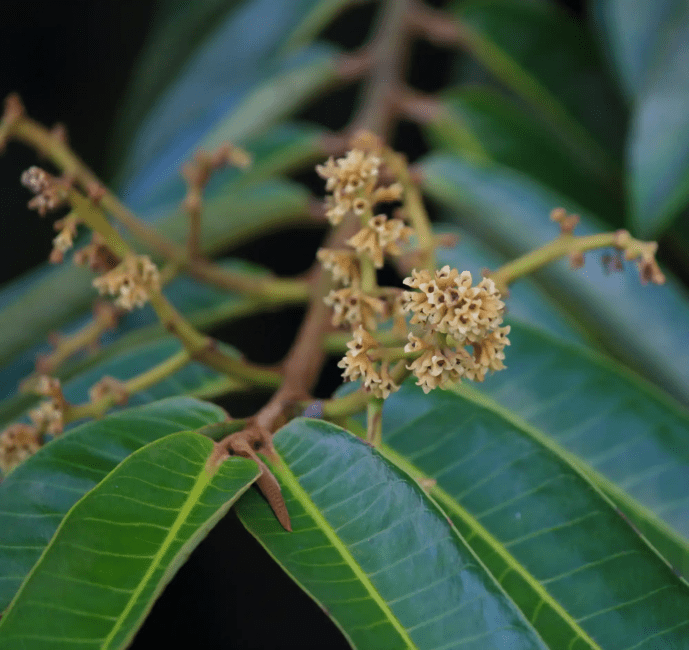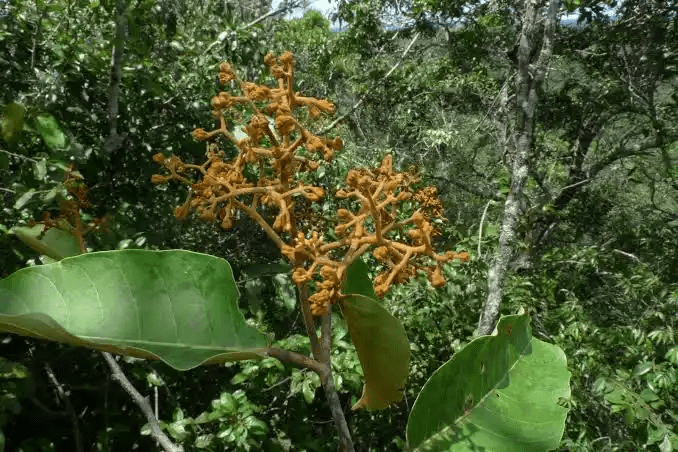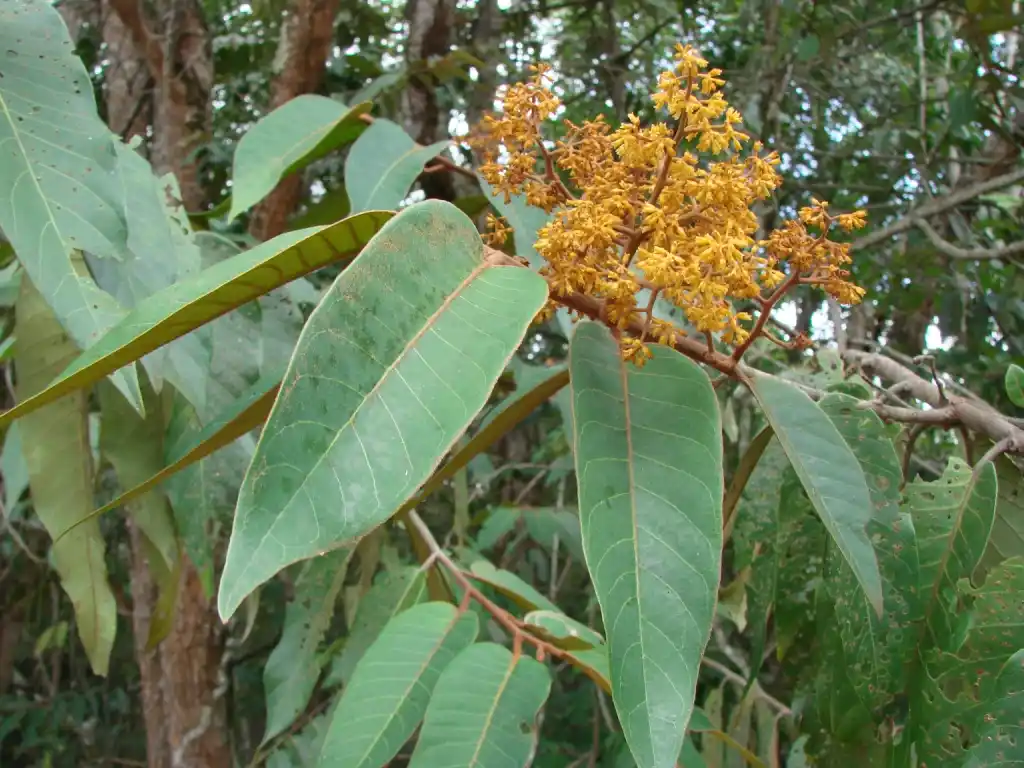Virola peruviana is commonly known as Cumala or Cumaúma. This species belongs to the Myristicaceae family and is found in the Amazon rainforest, particularly in regions of Peru.
Like other Virola species, Virola peruviana holds significance for both its ecological role and its traditional uses by indigenous communities.
The Cumala tree is characterized by its tall stature, often reaching heights of 30 to 40 meters. The trunk is straight, and the bark is smooth with a brownish hue.
The leaves are typically elliptical and arranged alternately along the branches. The tree produces small, inconspicuous flowers, and its fruits are capsules containing seeds surrounded by a fleshy aril.
In indigenous cultures, various parts of Virola peruviana have been used for traditional purposes. The seeds, in particular, are valued for the oil they contain.
This oil, sometimes referred to as Cumala oil, has been traditionally used in medicinal practices. It is believed to possess anti-inflammatory properties and is applied topically to treat conditions such as skin irritations and rheumatic pain.
Ecologically, Virola peruviana contributes to the biodiversity of the Amazon rainforest by providing habitat and sustenance for various wildlife species.
The fruits of the Cumala tree are an essential food source for certain animals, contributing to the intricate web of life in the region.
As with many species in the Amazon, Virola peruviana faces threats from deforestation, habitat degradation, and other human activities.
Conservation efforts are crucial to ensure the survival of this species and the preservation of the diverse ecosystems it inhabits. Sustainable management practices and community involvement play pivotal roles in safeguarding the Cumala tree and the broader biodiversity of the Amazon rainforest.
Understanding the cultural, medicinal, and ecological importance of Virola peruviana is essential for promoting conservation initiatives. By fostering a deeper appreciation for the intricate relationships between humans and the natural world.
We can work towards sustainable practices that protect not only individual species like Virola peruviana but also the entire ecosystem of the Amazon rainforest.
The Botanical Description of Virola peruviana
1. Life: Virola peruviana, commonly known as Cumala belongs to the Myristicaceae family. This tree, reaching approximately XX meters in height, boasts a straight, cylindrical trunk and smooth bark in varying shades of brown to gray.
2. Appearance: Its leaves, arranged alternately, display an elliptical or lanceolate shape, contributing to the tree’s aesthetic appeal.
3. Flowers: The small, fragrant flowers of Virola peruviana grow in clusters, showcasing a delightful array of colors, enhancing the tree’s visual allure.
The Geographic Distribution of Virola peruviana
1. Natural Habitat: Native to the Amazon rainforest, Virola peruviana thrives in the humid, tropical climate of South America. It prefers well-drained soils and is commonly found near riverbanks.
2. Range: This tree’s geographic distribution spans countries such as Peru, Brazil, Ecuador, and Colombia, illustrating its adaptability to diverse environmental conditions within the Amazon basin.
3. Ecological Significance: Virola peruviana plays a vital role in the rainforest ecosystem, contributing to biodiversity by providing habitat and sustenance for various species.
The Chemical Composition of Virola peruviana
1. Active Compounds: Renowned for its rich chemical composition, Virola peruviana features alkaloids, terpenes, and flavonoids. Specific compounds unique to this tree have been identified, contributing to its medicinal and cultural significance.
2. Medicinal Properties: The alkaloids present in the bark and seeds have potential medicinal properties, from analgesic effects to spiritual uses in indigenous rituals, showcasing the tree’s cultural importance beyond its botanical features.
3. Research and Applications: Ongoing research explores the diverse chemical compounds within Virola peruviana, with potential applications in pharmaceuticals. As we delve deeper, new possibilities for medical treatments and environmental conservation may emerge.
Read Also: 15 Medicinal Health Benefits Of Apocynum androsaemifolium (Spreading Dogbane)
The Medicinal Health Benefits Of Virola peruviana (Cumala)

1. Pain Relief: Virola peruviana is traditionally used for its analgesic properties, offering relief from various types of pain, including muscle aches and joint discomfort.
2. Anti-inflammatory Effects: The plant contains compounds that exhibit anti-inflammatory properties, potentially beneficial for conditions like arthritis and inflammatory disorders.
3. Spiritual and Ceremonial Uses: In indigenous cultures, Virola peruviana has spiritual significance, often used in rituals for its psychoactive properties and spiritual awakening.
4. Respiratory Support: Some traditional practices utilize Virola peruviana for respiratory issues, providing relief from symptoms like coughs and congestion.
5. Analgesic Poultices: Poultices made from Virola peruviana bark are applied externally to alleviate localized pain, especially in traditional medicine practices.
6. Antimicrobial Properties: Compounds found in Virola peruviana demonstrate antimicrobial effects, potentially useful in combating certain infections.
7. Psychoactive Uses: Certain indigenous groups use Virola peruviana for its psychoactive effects, contributing to altered states of consciousness during rituals.
8. Digestive Aid: The plant has been used traditionally to address digestive issues and stomach discomfort, offering potential relief.
9. Skin Conditions: Topical applications of Virola peruviana extracts are used in some cultures for skin conditions, benefiting from its properties.
10. Wound Healing: Virola peruviana extracts have been applied to wounds for their potential to accelerate healing and reduce infection risks.
11. Anti-parasitic Effects: Some traditional uses involve Virola peruviana in treating parasitic infections due to its potential anti-parasitic properties.
12. Mood Enhancement: In certain traditional practices, Virola peruviana is believed to have mood-enhancing effects, contributing to emotional well-being.
13. Toothache Relief: Traditional remedies include the use of Virola peruviana extracts for alleviating toothaches and oral discomfort.
14. Fever Reduction: In some cultural practices, Virola peruviana extracts are used to reduce fever and manage associated symptoms.
The Methods of Usage to Achieve the Provided Health Benefits Of Virola peruviana
1. Oral Ingestion: Virola peruviana extracts are consumed orally, often in ceremonial or spiritual contexts, to induce altered states or for medicinal purposes.
2. Topical Applications: Poultices or creams containing Virola peruviana extracts are applied externally to address localized pain, skin conditions, or wound healing.
3. Inhalation: In certain ceremonial settings, smoke or fumes from burning Virola peruviana bark or resin are inhaled for psychoactive or ritualistic purposes.
4. Infusions or Teas: Prepared from the bark or leaves, infusions or teas of Virola peruviana are used orally for various medicinal benefits.
5. Tinctures: Tinctures made from Virola peruviana extracts are used orally, providing a concentrated form for specific health concerns.
6. Mouthwash or Oral Rinses: Oral rinses made from Virola peruviana extracts are used for toothache relief or oral discomfort.
The Side Effects Of Using Virola peruviana Medicinal Plant
1. Psychoactive Effects: Ingestion or inhalation of Virola peruviana extracts may cause hallucinations or altered mental states, leading to potential risks if not used appropriately.
2. Gastrointestinal Distress: Oral consumption may lead to stomach discomfort, nausea, or vomiting in some individuals.
3. Allergic Reactions: Some people may have allergic reactions to Virola peruviana extracts, leading to skin irritation or respiratory issues.
4. Toxicity Concerns: Improper use or excessive consumption of Virola peruviana extracts may lead to toxicity and adverse health effects.
5. Dizziness and Disorientation: Psychoactive effects may include dizziness, disorientation, or confusion, impacting cognitive function.
6. Respiratory Irritation: Inhaling smoke or fumes from burning Virola peruviana may cause respiratory irritation or discomfort.
7. Interaction with Medications: Virola peruviana may interact with certain medications, affecting their effectiveness or causing adverse reactions.
8. Psychological Impact: The psychoactive effects may have profound psychological impacts, requiring caution in use, especially in vulnerable individuals.
9. Cardiovascular Effects: Some individuals may experience changes in heart rate or blood pressure due to the plant’s effects.
10. Prolonged Psychoactive States: Extended psychoactive states from Virola peruviana use may lead to prolonged altered mental states, affecting daily functioning.
Read Also: How to Manage Weeds Effectively in Organic Farming
The Scientific Research and Studies of Virola peruviana

1. Ethnobotanical Significance: Scientific research on Virola peruviana encompasses its ethnobotanical importance among indigenous communities. Studies explore its traditional uses, spiritual significance, and cultural practices associated with the plant.
2. Medicinal Properties: Extensive scientific studies focus on the medicinal potential of Virola peruviana. Research investigates its compounds for analgesic, anti-inflammatory, and psychoactive properties, aiming to validate traditional medicinal uses and discover new therapeutic applications.
3. Ecological Impact: Scientific research also delves into the ecological impact of Virola peruviana within its habitat. Studies examine its role in biodiversity, interactions with other species, and its contribution to the ecosystem’s stability.
The Safety Precautions and Recommendations In Using Virola peruviana Medicinal Plant
1. Consultation: Before using Virola peruviana medicinally, consult a qualified healthcare professional or herbalist to understand potential risks and proper usage.
2. Dosage Control: Adhere strictly to recommended dosages. Excessive consumption may lead to adverse effects.
3. Allergic Reactions: Be cautious of potential allergic reactions. Some individuals may experience allergies to certain components of Virola peruviana.
4. Pregnancy and Lactation: Avoid use during pregnancy or lactation unless advised by a healthcare provider due to potential risks.
5. Interaction with Medications: Check for potential interactions with existing medications before using Virola peruviana to prevent adverse effects or reduced efficacy of medications.
6. Harvesting Practices: If harvesting the plant, do so sustainably and ethically to preserve the species and its habitat.
7. Mental Health Considerations: Exercise caution due to the psychoactive properties of certain compounds in Virola peruviana, especially if dealing with mental health conditions.
8. Children’s Use: Keep Virola peruviana out of reach of children. Its effects on children are not well-studied and may pose risks.
9. Medical Conditions: Individuals with specific medical conditions, such as liver or kidney disorders, should use Virola peruviana cautiously or avoid it altogether.
10. Side Effects Monitoring: Be vigilant for any side effects or adverse reactions while using Virola peruviana and seek medical attention if needed.
11. Long-term Use: Prolonged or excessive use of Virola peruviana may have unknown long-term effects. Use with caution and moderation.
FAQs About Virola peruviana Medicinal Plant
1. Is Virola peruviana safe for consumption?
Yes, when used appropriately and in moderation. However, consult a healthcare professional for guidance.
2. Are there known side effects of using Virola peruviana?
Possible side effects include nausea, dizziness, and allergic reactions in some individuals.
3. Can Virola peruviana be used during pregnancy?
It’s not recommended during pregnancy due to potential risks to the fetus.
4. Does Virola peruviana interact with medications?
It may interact with certain medications. Consult a healthcare provider before use.
5. What is the recommended dosage of Virola peruviana?
Dosage varies and should be determined by a qualified practitioner.
6. Can Virola peruviana be used for mental health purposes?
Some compounds have psychoactive properties; caution is advised, especially for mental health concerns.
7. Is it safe for children to use Virola peruviana?
Its effects on children are not well-understood; keep it away from children.
8. How should Virola peruviana be harvested sustainably?
Ethical and sustainable harvesting practices help preserve the species and its habitat.
9. Are there specific medical conditions that contraindicate the use of Virola peruviana?
Individuals with certain medical conditions should use it cautiously or avoid it.
10. Can Virola peruviana cause allergic reactions?
Some individuals may be allergic to components of Virola peruviana.
11. Is Virola peruviana legal to use in all regions?
Legal status may vary by region; check local regulations before use.
12. What are the known traditional uses of Virola peruviana?
Traditional uses include medicinal and ceremonial practices among indigenous communities.
13. Are there documented cases of Virola peruviana overdose?
Cases of overdose are rare but may result in severe adverse effects.
14. How does Virola peruviana contribute to ecosystem health?
Its role in biodiversity and ecosystem stability is being studied by researchers.
15. What are the potential long-term effects of using Virola peruviana?
Long-term effects are not well-documented; moderation in use is advisable.
16. Can Virola peruviana be used in conjunction with herbal supplements?
Caution is advised due to potential interactions; consult a healthcare professional.

